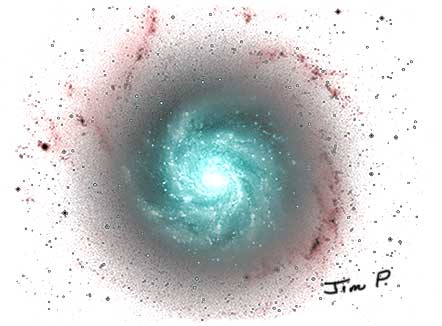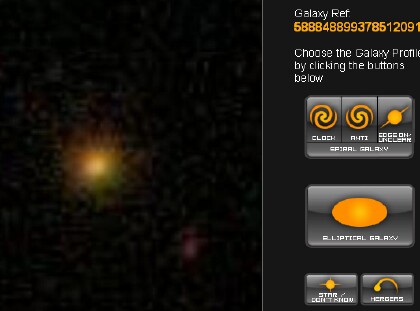Can You Classify That Galaxy?

Spiral Galaxy M101 by Jim Plaxco
Some of you may recall the Mars crater identification project that asked for volunteers to identify martian craters. Named Clickworkers, the project has since been expanded to include review of Mars Reconnaissance Orbiter HiRISE camera images. More about that in an upcoming post.
Now a similar project has been created for the purpose of classifying galaxies. Galaxy Zoo, which opened July 10, is an online project that uses volunteers to visually inspect small deep space pictures in order to identify the type of galaxy seen in the image.
Your job as a classifier of galaxies is to determine whether the image is of a spiral galaxy, elliptical galaxy, merging galaxies, or not a galaxy at all. If it is a spiral galaxy, then one needs to identify whether its rotation is clockwise or anti-clockwise. Figure 1 below shows a sample screen shot, reduced in size for display here.

Figure 1. Galaxy Zoo screen shot shown reduced in size.
Unlike Clickworkers, Galaxy Zoo volunteers need to register and pass a test. The test consists of correctly identifying at least 8 of 15 galaxy images. When I took the test I got 13 out of 15 correct. I'm fairly sure of the ones I got wrong. These were objects that were quite fuzzy and I basically just gave it my best shot. Unfortunately there is no feedback given to tell you which ones you did get wrong. That feedback would definitely be useful.
Once you've passed the test, you are then free to begin analyzing galaxy pictures. One word of caution: the galaxies that are used in the tutorial section to give you practice at identifying galaxies are, in my opinion, representative of rather clear cut cases. Many of the galaxy images that you are asked to classify are little more than pixellated smudges so be prepared for a challenge.
While classifying, one cool tool at your disposal is the SDSS Skyserver Object Explorer. You access this tool by clicking on the Galaxy Ref. link (see orange text, upper right in Figure 1). There you will find quantitative information about the image you are analyzing. From this tool you can click on the image shown which takes you to a new window for the SDSS DR6 Finding Chart Tool. This tool allows you to zoom in and out on the image you are analyzing. You may find this useful for those hard to classify galaxies.
There are a Sagan's#1 worth of galaxies awaiting classification so what are you waiting for, get over to Galaxy Zoo because the more of us that help, the quicker the job will be done. Incidentally, M101 (the galaxy shown at the top of this post) is a counter-clockwise rotating spiral galaxy.
Note 1. One Sagan = Billions and billions.
Ad Astra, Jim
| Return to the Blog Index | This entry was posted on Friday, July 20th, 2007 at 6:42 am and is filed under Astronomy.